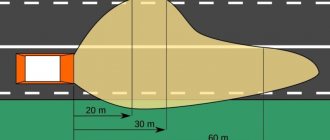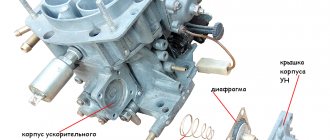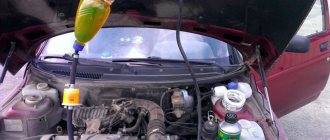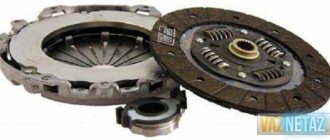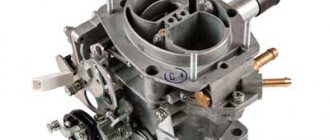In the 1970s, mechanical inventor Tom Ogle created a new type of carburetor. Although Ogle's device was tested and allowed to travel up to 48 kilometers on one liter of fuel, it was never produced commercially.
The principle of operation of the carburetor was based on heating gasoline to produce steam, which then entered the combustion chambers. This required the fuel tank to be structurally supported, similar to a pressure vessel. Not only did Ogle’s invention significantly save motorists money, it almost did not pollute the atmosphere.
The inventor even claimed that the exhaust from a car equipped with his carburetor could “ dry your hair.”
».
Representatives of gas and oil companies repeatedly approached Ogle, offering money to “freeze” development. However, the inventor invariably refused (although there were rumors that he eventually sold his brainchild).
And on August 19, 1981, Ogle fell and died. An autopsy revealed that the cause of death was an overdose of propoxyphene and alcohol. The death was ruled a suicide after a cursory investigation, but several people close to Ogle indicated they did not believe the young mechanic would have killed himself. The works of Tom Ogle are remembered by everyone as the most mysterious in the history of the automotive industry, as well as his mysterious death... This invention is really considered “missing” from 1981 to the present day, there are only prototypes with much more modest performance...
OK- › Blog › Ogle carburetor, GM EV1 and others
Any car owner would like to drive as long as possible on one tank of fuel, and modern hybrid cars are already showing very good results in terms of efficiency. Unfortunately, automakers still haven't achieved even a fraction of the success of mechanic Tom Ogle. In the 1970s, this inventor created a new type of carburetor, the likes of which had never been seen before.
Although Ogle's invention was successfully tested and showed results of 48 kilometers per 1 liter of gasoline, it was never produced commercially. The revolutionary engine worked on the principle of introducing gasoline under high pressure into a cloud of steam, which was then injected into the internal combustion chamber. As a result, Ogle was denied a patent for his invention, and he took it to his grave.
Comments 6
the respected professor Mendeleev said that burning petroleum products is the height of wastefulness and stupidity...
Alas, at the moment there is no more capacious “container” of energy.
The fundamental flaw of modern natural science, which significantly reduces the number of possible discoveries... - And what is it? — In an effort to unify knowledge. The search for a certain “universal principle” (c) McGuire Arthur Atommash Book 2. A leap to the future"
Dad, who were you talking to just now?
Yes, a little bit of everyone)
Alas, at the moment there is no more capacious “container” of energy.
Atomic energy at a power plant, battery in an electric car.
Tuning the Solex 21083 carburetor to improve technical characteristics
Many car enthusiasts prefer to increase the efficiency of the factory carburetor, thereby making a number of modifications.
Tuning the Solex 21083 carburetor is an excellent opportunity to most optimally customize the fuel supply system to suit your preferences and driving style. Thus making your car more responsive and playful, the technical characteristics in this case are improved, but, as a rule, you have to sacrifice efficiency.
This carburetor can also be installed on the nine, so when tuning the VAZ 2109 engine, you can at the same time take care of tuning the carburetor, because one complements the other. And in the end you will get a very fast car that can compete with foreign cars. And in general, do-it-yourself tuning is a good thing and very useful for the car and its owner.
Cloud Destroyer
It would be great to make it rain when it's needed. It was this problem that the scientist Wilhelm Reich dealt with, who in 1953 created an invention called “Cloudbuster” (Cloud Destroyer). It was supposed to help farmers in Maine, as a long drought threatened to destroy their blueberry crops. When Reich made his first attempt to launch his creation, the forecast for the area was sunny. Several hours passed after the machine was started and thunderclouds appeared in the sky. And then about 0.64 centimeters of rain fell on the ground. After this, the government seized his records and prototypes of the device from the Reich. And there was no new Cloudbuster test. But the “Cloud Destroyer” might have been able to solve the problem of food shortages in the arid regions of the Earth.
Tuning the VAZ 2106 engine
The VAZ “six” began to be produced back in 1976. This model is long outdated both in appearance and technical characteristics. However, to this day there are still many adherents of using such cars. Some owners try to keep the car in its original form, others equip it with modern components and mechanisms. One of the primary units that undergoes tuning is the engine. Let's look at its modifications in more detail.
Cylinder block boring
The VAZ 2106 engine does not stand out for its power, because it ranges from 64 to 75 hp. With. with a volume of 1.3 to 1.6 liters, depending on the installed power unit. One of the common engine modifications is boring the cylinder block, which allows you to increase the internal diameter of the cylinders and power. The boring process involves removing a layer of metal from the inner surface of the cylinders. However, you need to understand that excessive boring will lead to thinning of the walls and a decrease in the reliability and service life of the motor. Thus, the stock power unit with a volume of 1.6 liters and a cylinder diameter of 79 mm can be bored to 82 mm, giving a volume of 1.7 liters. With such changes, reliability indicators will practically not deteriorate.
Extreme enthusiasts can increase the cylinders to 84 mm at their own peril and risk, because no one knows how long such an engine will last.
The boring process is carried out on special equipment (boring machine), although there are craftsmen who carry out this procedure almost in a garage, and the accuracy remains questionable.
At the end of the procedure, pistons are inserted into the block, which in their characteristics correspond to the new cylinder sizes. In general, block boring consists of the following main stages:
- Removing the engine from the car.
- Complete disassembly of the power unit.
- Boring the cylinder block according to the desired parameters.
- Assembly of the mechanism with replacement of pistons.
- Installing a motor on a car.
Video: how to bore a cylinder block
Replacing the crankshaft
The engine of the VAZ “six” has a VAZ 2103 crankshaft with a piston stroke of 80 mm. In addition to increasing the cylinder diameter, you can increase the piston stroke, thereby boosting the engine. For the purposes under consideration, the engine is equipped with a VAZ 21213 crankshaft with a piston stroke of 84 mm. This way it will be possible to increase the volume to 1.65 liters (1646 cc). In addition, such a crankshaft has eight counterweights instead of four, which has a positive effect on the dynamic characteristics.
Refinement of the intake and exhaust system
Upgrading the cylinder head and manifolds, if desired, can be done by anyone who owns a “six” or another classic Zhiguli model. The main goal pursued is to increase power. It is achieved by reducing the resistance when supplying the fuel-air mixture at the inlet, i.e. by removing roughness. To carry out the procedure, the cylinder head must be removed from the vehicle and disassembled. After this, it is recommended to wash the unit. For these purposes, you can use modern means or ordinary kerosene or diesel fuel. From the necessary list of tools and materials you will need:
- drill with the ability to adjust speed;
- drill;
- flexible rod;
- rollers;
- skins of different grain sizes;
- rags;
- calipers;
- exhaust valve and set of washers for boring over 32 mm;
- graphite lubricant;
- vice.
Intake manifold
It is better to start the procedure for modifying the intake tract with the manifold, through which the channels in the cylinder head will then be bored. We carry out the work as follows:
- We clamp the collector in a vice, wrap a rag around a drill or a suitable attachment, and on top of it - overlapping sandpaper with a grain size of 60–80.
Refinement of the cylinder head
In addition to the intake manifold, it is necessary to modify the channels in the cylinder head itself, since there is a step between the manifold and the cylinder head that prevents the free passage of the fuel-air mixture into the cylinders. On classic heads this transition can reach 3 mm. Refinement of the head comes down to the following steps:
- To determine where part of the metal needs to be removed, apply lubricant or plasticine to the plane of the head in the places where the commutator fits. After this, it will be clearly visible where and how much to grind off.
In addition to boring the channels, the cylinder head can be modified by installing a tuned camshaft. Most often, car owners install a shaft from a VAZ 21213, less often - sports elements of the “Estonian” type and the like.
Replacing the standard camshaft makes it possible to change the valve timing. As a result, the engine cylinders are better filled with the combustible mixture and are also cleaned of exhaust gases, which increases the power of the power unit. The camshaft is changed in the same way as during normal repairs, i.e. no special devices are required.
Video: modification of the cylinder head and intake manifold
An exhaust manifold
The essence of modifying the exhaust manifold is the same as for the intake. The only difference is that the channel needs to be sharpened no more than 31 mm. Many people do not pay attention to the exhaust manifold because it is made of cast iron and is difficult to machine, but it is still possible. It is worth considering that the collector channel should be slightly larger in diameter than in the head. In the cylinder head itself, grinding is carried out using the method described above, and it is recommended to grind the bushings to a cone.
Electronic coding system
At the end of the 20th century, Jan Bernhard Sloot developed a revolutionary data compression technique. According to the author of the invention, he managed to compress a film of one gigabyte to 8 kilobytes. Sloot demonstrated the success of his project by playing 16 movies from a single 64 kilobyte chip. Investors had already attacked Sloot with offers to buy this incredible invention, but the innovator died under suspicious circumstances.
Electric car (not hybrid)
In the late 1990s, General Motors was the first to market an all-electric car, the GM EV1. However, it was not intended for mass production. The company produced only 1,117 cars and all of them were available only for leasing.
According to reports at the time, GM decided that customers were unhappy with the batteries installed in the car and preferred to switch to more modern gasoline options. But there is an assumption that large oil companies simply put pressure on the corporation.
Tom Ogle Carburetor
In the 1970s, mechanical inventor Tom Ogle created a new type of carburetor. Although Ogle's device was tested and allowed to travel up to 48 kilometers on one liter of fuel, it was never produced commercially. The principle of operation of the carburetor was based on heating gasoline to produce steam, which then entered the combustion chambers. This required the fuel tank to be structurally supported, similar to a pressure vessel. Not only did Ogle’s invention significantly save motorists money, it almost did not pollute the atmosphere. The inventor even claimed that the exhaust from a car equipped with his carburetor could “dry your hair.”
Representatives of gas and oil companies repeatedly approached Ogle, offering money to “freeze” development. However, the inventor invariably refused (although there were rumors that he eventually sold his brainchild). And on August 19, 1981, Ogle fell and died. An autopsy revealed that the cause of death was an overdose of propoxyphene and alcohol. The death was ruled a suicide after a cursory investigation, but several people close to Ogle indicated they did not believe the young mechanic would have killed himself.
Causes of carburetor contamination and methods for detecting malfunctions
Before we look at cleaning the carburetor, let's find out why, in fact, it gets dirty?
As you know, the carburetor prepares a combustible mixture for the engine from fuel and air, mixing them in certain proportions. Thus, the source of carburetor contamination can be either fuel or air. Air and fuel filters can reduce the degree of contamination, so you need to monitor their condition and change them on time.
Any carburetor is a very precise device, and even a slight clogging of the fuel or air jets, which causes a decrease in the flow area of the holes, will inevitably lead to problems with the engine or even make the engine impossible to operate.
Today, to check carburetor operation and maintenance, many service stations have special devices - exhaust gas analyzers. Based on the composition of the exhaust gases, such devices can detect problems with the carburetor or incorrect adjustment. This testing method is considered the most accurate, but if such a device is not available, then the same but less accurate diagnosis can be carried out based on the condition of the spark plugs.
With a normal composition of the combustible mixture, its electrodes and insulator have a gray-brown color. If the spark plug is black due to carbon deposits, then the carburetor is preparing too rich a mixture, and if the spark plug is white or light gray, then the combustible mixture is poor.
Materials and tools for carburetor maintenance
If such problems are detected in the operation of the carburetor, then it needs to be cleaned and adjusted, that is, the carburetor needs to be serviced. Before you start working with the carburetor, you need to stock up on all the necessary materials and tools.
- clean, lint-free rags, a special product for cleaning carburetors (can be bought at the store);
- rubber gloves to protect hands from the action of the cleaner;
- a small solvent-resistant container where you can put carburetor parts;
- it is advisable to buy a special can of compressed air, with which it is convenient to blow out the jets and other holes in the carburetor, but in extreme cases you can get by with a regular pump for inflating tires;
- stock up on an old toothbrush and toothpicks - they will help with the work;
- You will also need tools for disassembling the carburetor - screwdrivers and wrenches;
- To protect your eyes from contact with cleaning agents, we recommend wearing safety glasses.
By the way, when it comes to buying a carburetor cleaner, choose not just the first cleaner you come across, but products designed specifically for cleaning carburetors, otherwise there is a risk of damaging carburetor parts and rendering it unusable. Of course, before using the cleaner, do not forget to carefully study the instructions.
Rife device
In third place in the ranking of amazing and forgotten inventions these days is a machine for treating cancer. In 1934, it was created by the American inventor Royal Rife. Using a specially designed microscope, he was the first person to be able to see a living virus, too tiny to be visualized using previously existing technology. After this, Rife demonstrated a device - a broadband generator of electromagnetic waves - capable of destroying pathogens. Through long experiments, Rife created a table of frequencies that are harmful to pathogens of various diseases.
There are 14 documented cases of Rife curing cancer patients whose illness was at a terminal stage. However, when the scientist refused to cooperate with the head of the American Medical Association (AMA), the organization used all its powers to devalue Rife's work. The researcher accused the AMA, the Department of Public Health and other medical organizations of conspiring to fire and discredit him. He created the Beam Ray company, which produced 14 devices, but the company soon went bankrupt, the doctors who supported and collaborated with Rife received grants for other research, and again prescribed traditional cancer drugs to patients, and the doctor himself despaired and became an alcoholic.
This is interesting: Do-it-yourself car diagnostics via a laptop
water car
Taking a quick ride in a car filled with water is still a pipe dream. But it could come true if Stan Meyer’s invention went into mass production. This magnificent car consumed a liter of water for 43 km. Colleagues close to Meyer said he was under great pressure to stop working on water-powered machines. But Meyer refused to bury his invention. Although the same colleagues and friends claimed that Meyer was poisoned because of his refusal to bow to the big oil corporations, it is documented that the inventor died suddenly of a brain aneurysm.
Modification of Ozone carburetors 2107-1107010 and its modifications
Modification of Ozone carburetors 2107-1107010 and its modifications
Among the light modifications, I can suggest returning the design closer to its origins, i.e., to the DAAZ 2101 carburetor - introducing a mechanical drive for the throttle valve of the secondary chamber (it is better to neglect throwing the spring out of the pneumatic drive) and removing the capricious electronics (applies to carburetors for cars 2105 and 2107 with the " Cascade"). The carburetors that are installed on cars 2103 and 2106 do not have this system (and thank God)
Free energy
In the first place in the list of great lost inventions that were not given a start is the creation of the famous Nikola Tesla. He wanted to give humanity free energy and, through well-documented tests, demonstrated that he could make his dream a reality. Tesla is known to have developed prototypes that enhance wireless power transmission and can provide electricity to large areas, "powered" by just one tower. Although most people supported Tesla's idea, funding for his project was reduced to zero, and the scientist's laboratory mysteriously burned to the ground. Free energy is perhaps the most documented and globally significant project of all unrealized useful inventions in the world.
How to make a return line on a carburetor yourself
Why do you need a return line on the carburetor? It turns out that the idea is to continuously operate the fuel pump, which pumps fuel even on descents when the engine is braking. Fuel enters the system intensively, but is not burned in full, which leads to excessive load on the line. As a result, steam plugs form and pressure decreases.
His Majesty diffuser
As you can see, the diffuser occupies not the last place in this hierarchy, and here’s why. The main problem with Solex DAAZ 21083 is that the standard mixture is too lean. The engineers deliberately took this step in order to strangle the engine in favor of efficiency, depriving it of its dynamic potential. But even without resorting to complex and subtle calculations, it is clear that first of all it is necessary to eliminate aerodynamic errors, which are full of any DAAZ carburetor.
If you pick up a diffuser, large or small, pay attention to the quality of the casting and show all this happiness to an engineer at least from Ford Europe, he will go crazy. A standard diffuser creates so many turbulences and parasitic flows in the intake tract that the efficiency of the carburetor is reduced by 20 percent. What kind of tuning can we talk about with such diffusers! Therefore, first of all, they need to be sanded, removing all the seams that create swirls.
Pros and cons of modernization
A do-it-yourself return line will reduce the load on the needle of the carb's float chamber and relieve pressure on the valves. In addition, the return flow will allow gasoline to constantly flow through the system and not stagnate in one place, which will prevent the fuel from boiling, for example, in extreme heat in the summer.
Without a return line, some cars, especially used ones, consume a lot of fuel. If, for example, a passenger car consumes more than 14 liters per 100 kilometers, it is necessary to upgrade the system.
The disadvantages of such modernization include difficulties with launching. For example, some drivers experienced this situation. They write that the car behaves great on the highway, the throttle response and other characteristics are excellent. However, as soon as you brake and leave the engine to idle for a while, it stalls and is not going to start again. Only after the hood opens does the situation become clear: it turns out that the fuel filter is empty and air is coming from the return line. As long as you don't pinch the line, pumping doesn't happen.
This is the only disadvantage of manufacturing and installing a return line to the carb. And this does not necessarily happen on all machines, but it should not be ruled out.
On some car models with a Solex carburetor, return flow is provided as standard. The manual says that it is designed to prevent fuel from leaking out of the tank when the car overturns. In other words, it was done to improve fire safety.
For the first time something similar appeared on the GAZ 24 with K-126 carburetors. Only this was not a full-fledged return, but only a tee that ensured that fuel was drained back into the tank through a small hole. The goal is to maintain pressure in front of the carburetor.
The process of setting up a Solex carburetor
To adjust the 21083 carburetor for the UZAM engine, you should start by setting a specific level in the float chamber. Level adjustment must be made relative to the lid. To perform this operation, you need to use a special template suitable for your type of carburetor. Such a template is usually found in a special user manual. Without it, you will not be able to complete this task yourself.
After adjusting the float level, you need to make an adjustment for the idle speed.
To do this, you need to perform a number of sequential operations:
- Remove the fully tightened quality screw. It is in the position of approximately 6 turns. When the vacuum in the vacuum hose disappears, you need to stop rotating. This hose is directed to the distributor.
- Check the power plant, which is in a warm state. The test is to see if the engine can maintain idle speed from a thousand to 1500 per minute. If the number of revolutions reaches 800 per minute, then this number should be reduced. To achieve this, you need to additionally unscrew the screw.
- In order to achieve stable operation of your engine, provided that the mixture is as lean as possible, you need to turn the screw more gradually. It is worth understanding that the more the screw is tightened, the leaner the mixture, and therefore CO2 emissions will be minimal.
- For a warm engine, you need to set the idle speed to around 900 per minute. This number is suitable for the summer period of the year. And in winter it will require approximately 1000 rpm.
Depending on the size of your engine, the choice of jet is made. Remember that the larger the engine volume in your car, the less jets are needed.
For the first chamber, a fuel and then an air nozzle are initially selected. After this, jets are selected for another chamber.
What to prepare
The return is done through a tee. A hose that can withstand gasoline pressure is also used. Its length of 70 cm will be sufficient. You will need a check valve from the V8, a fuel pump filter and about a dozen metal clamps.
It is also recommended to use a 125 carburetor fuel jet. You just need to modernize it - make a thread, carefully work on the fitting. You need to make a smaller hole in the plug than in the fitting.
The price of parts that will be used in the modernization process will not exceed 100 rubles. You can use old hose and filter. They're probably lying around in the garage.
